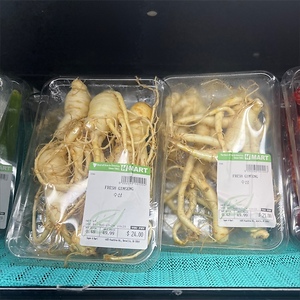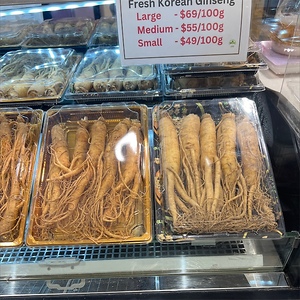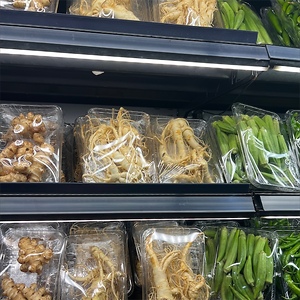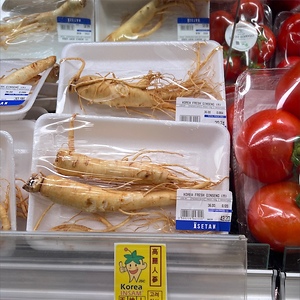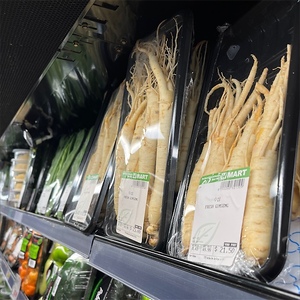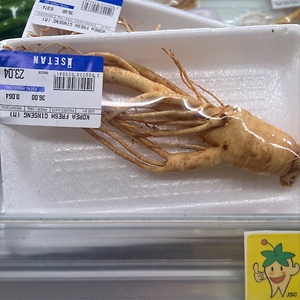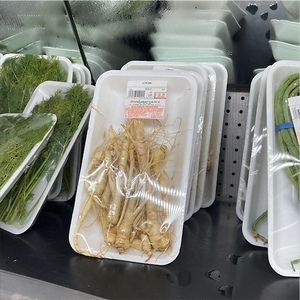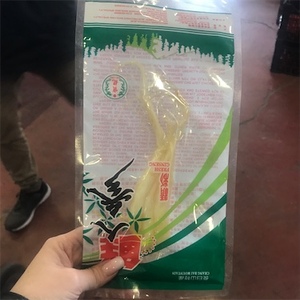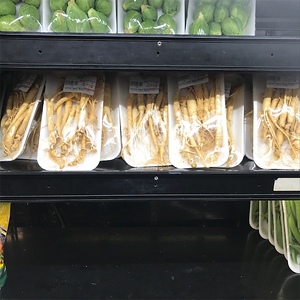


Ginseng Root
Estimated Inventory, lb : 0
Description/Taste
Ginseng roots are a small vegetable also known as a rhizome. This thick, fleshy root is longer than wide, usually measuring about 5 to 15 centimeters in length and 1 to 2.5 centimeters wide. Ginseng is sometimes called "man root" because of the way smaller roots may branch off its larger branches, resembling arms or additional limbs. The primary root, or tap root, loosely resembles a carrot with multiple branches extending off it. The outer skin of the Ginseng root has a creamy white-yellow color with brown spots where the branches extend off of it. When cut open, the inner flesh of the rhizome is a lighter off-white tone that feels smooth yet firm and fibrous. It has a slight juiciness when bitten into, though not comparable to more succulent fruits or vegetables. Ginseng root has an earthy scent that is slightly sweet yet bitter, which is also reflected in its taste. It has significant notes of bitterness that can be compared to licorice or radish.
Seasons/Availability
Ginseng roots are available from early fall through mid-winter.
Current Facts
Ginseng root is botanically classified as Panax Ginseng. It’s one of seven hundred plant species in the Araliaceae family which includes parsnips, celery, and carrots. It’s also referred to as Asian Ginseng, Chinese Ginseng, and Korean Ginseng. This form of Ginseng should not be confused with American Ginseng as they belong to two different species that contain different versions of the chemical ginsenoside. Panax Ginseng is the most widely used species of Ginseng and is sometimes considered an adaptogen, meaning that it can help counteract the impact of stress on the body. Ginseng is commercially sold in thirty-five countries throughout the world. The name Ginseng is of Chinese origins and comes from the term Hokkien jîn-sim, meaning “human root,” referring to the fact that Ginseng loosely resembles a human body. This is taken a step further in some Asian traditions where Ginseng is seen as a representation of how a person goes through physical and spiritual changes.
Nutritional Value
Ginseng root is distinguished for its many health and medicinal properties. It contains active chemicals called ginsenosides or panaxoside that may potentially help with memory, cognitive skills, and alleviating symptoms of Alzheimer's and depression. It has been historically used as an agent for boosting immunity, enhancing gut health, healing kidney and adrenal functions, and improving lung health. Ginseng root may be used as a tonic for your spleen and for anti-aging purposes. It is often available in tablets or capsules but may also be consumed in teas and supplements. Though generally safe, Ginseng may lead to side effects like heart palpitations, confusion, and headaches. Those who are pregnant or breastfeeding, have high blood pressure or heart issues or are on blood thinners may also want to avoid using Ginseng root.
Applications
Fresh Ginseng root is widely used as a principal ingredient in Chinese and Korean cuisines, where it is an essential pantry ingredient. Adding Ginseng to soups brings out its anise-flavored profile and earthy tendencies, especially when paired with ginger, dates, and pork. Ginseng root can be added to energy drinks, chips, gum, yogurt, oatmeal, smoothies, coffees, and juices. One of the most common ways to prepare Ginseng is by boiling it to make tea, a concoction that’s said to help relieve stress, improve stamina, and increase focus. The tea is often mixed with honey to counteract the bitterness of Ginseng root. Complimentary foods to Ginseng root include cloves, Chinese rosebuds, cinnamon, five spice, hazelnuts, curry, alliums, poultry, fermented beverages, chiles, malted barley, basil, rosemary, stone fruits, strawberries, and pineapple.
Ethnic/Cultural Info
Ginseng’s genus Panax means "total healing" in Greek. This reflects its historical reputation as a universal remedy, a notion rooted in ancient traditions and documented extensively in texts like the "Guguepganyibangeanhae" from 1489 and the "Annals of King Jeongjo" from the late 1700s. Ginseng root has been used in traditional Chinese medicine for over 2000 years. White and Red Korean Ginseng have historically been used to strengthen digestion, calm the mind, and expel negativity. Cultivating Ginseng roots dates back to 11 BC in Korea, but according to the text “Do Hong-Gyeong,” the process of steaming Ginseng did not start until 1123. This text also details 365 different types of herbs and categorizes them into high, mediocre, or low during the Yuan dynasty. Within this system, Ginseng was classified as one of the highest-quality herbs.
Geography/History
Ginseng Root is native to the mountainous regions of East Asia. It can grow in similarly cold climates throughout the Northern Hemisphere in places like Japan, America, and Russia. It is most frequently found in the wild. After its medicinal properties were recognized and it became a highly sought-after remedy, Ginseng reached peak popularity in the 18th century when American colonists discovered native Ginseng varieties. By the 20th century, the demand for Ginseng outstripped the available wild supply, causing it to become increasingly endangered and making it one of the most expensive herbs in the world. These days, Ginseng can be found in grocery stores, specialty stores, and foraged in the wild.
Recipe Ideas
Recipes that include Ginseng Root. One



